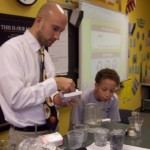Successful Academics: The Arts Play a Vital Role
 I was recently invited to speak at a private school in Cleveland to share some thoughts from Being Visual. Having the amazing opportunity to witness first-hand how vital the role of art education is to a child’s successful academic career. Agnon is a wonderful school, with evidence all around that the arts are highly valued and considered key to a strong educational experience. While talking to the Headmaster, Jerry Isaak-Shapiro, I also found out about their integrated curriculum and commitment to minimal testing. The parents at this school are involved in their children’s education and seemed as committed to their own education, as they were to their children’s.
I was recently invited to speak at a private school in Cleveland to share some thoughts from Being Visual. Having the amazing opportunity to witness first-hand how vital the role of art education is to a child’s successful academic career. Agnon is a wonderful school, with evidence all around that the arts are highly valued and considered key to a strong educational experience. While talking to the Headmaster, Jerry Isaak-Shapiro, I also found out about their integrated curriculum and commitment to minimal testing. The parents at this school are involved in their children’s education and seemed as committed to their own education, as they were to their children’s.
While sharing information on learning styles, our conversation became focused on the strengths and needs of visual learners. This topic happens to be my personal passion. As I shared tips and tools to help visual children at home, the responses were very interesting.
Here are just a few snippets of our conversation:
“I now understand why my son struggles in math.”
So we talked about ways to help them better understand math concepts, use manipulatives and gain skill and interest in computation.
“I am so left brain, my daughter is also very left, but I can see that my son thinks differently.”
So we talked about her son’s strengths and ways to celebrate them, but help him build the skills needed to write and study more effectively.
“I’m a doodler, but my husband thinks it’s a distraction.”
While signing her copy of my book, she had me dedicate the section on effective study and doodling to him!
I truly enjoyed my time with these educators and parents and was inspired by their dedication and passion.
Are you curious about what makes your child tick in the classroom? I’d love to hear your thoughts.
Are you curious to know more about your child’s learning style?
 |
Bette FetterFounder and CEO of Young Rembrandts and Author of Being Visual |











October 16, 2012 @ 11:26 am
The Right Brained Learner comprises approximately 95% of our clientele! We successfully incorporate such techniques as visualization, visual-motor integration, art therapy, and drama therapy to effectively manage classroom-based struggles.
Your programme sounds phenomenal and we sound extremely like-minded!